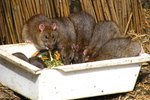
Popular culture gives the impression that foxes live on rabbits, but they actually eat a wide variety of food. They are highly adaptable and their diet varies with location and seasonal availability. Species include the red fox, fennec fox, gray fox, kit fox and arctic fox. The red fox is found throughout Europe, Asia, North America and the United Kingdom and is the most widely distributed carnivore in the world.
What Foxes Eat
Foxes are omnivores and eat small mammals, birds, reptiles, frogs, eggs, insects, worms, fish, crabs, mollusks, fruits, berries, vegetables, seeds, fungi and carrion. In winter they mainly eat mammals, such as mice, rabbits and other small animals. In autumn their preference is fruit and berries like blackberries, apples and persimmons, plus acorns, sedges and tubers. In summer they eat lots of insects like crickets, beetles and caterpillars as well as frogs and mice. In spring they will fill up on birds' eggs and earthworms. They will even wade into shallow water for fish and crabs.
How They Hunt
Foxes do a lot of hunting at dawn and dusk, but can hunt anytime. They hunt by stalking their live prey. They have excellent hearing and use a pouncing technique that allows them to kill the prey quickly. They listen for animals moving underground or under the snow in winter and use a combination of pouncing and digging to get to it. With larger prey such as rabbits, they stalk until they are close, but wait to attack until the rabbit turns to run away.
How Cubs Learn to Hunt
The cubs initially live on their mother’s milk, but when they are about a month old their mother will begin to regurgitate meat she has eaten for them. Soon after, they will be allowed to leave the den for play sessions and she will bring back small live prey like mice, frogs and grasshoppers in order to teach them how to kill. Eventually they will be allowed to go hunting with her. She'll teach them to hide unused food in caches for later.
Rural vs. Urban Fox Diets
Human activities often attract mice and rats, and traffic increases the amount of carrion through roadkill. Urban foxes take advantage of these food sources and are more likely to eat rats and pigeons than their rural counterparts. Sometimes people leave food out for foxes and they will also scavenge pet food left in gardens, and bread and other food left out for birds. They are opportunistic and will also scavenge edible matter from garbage bins.
References
Resources
Photo Credits
-
Jupiterimages/Photos.com/Getty Images




